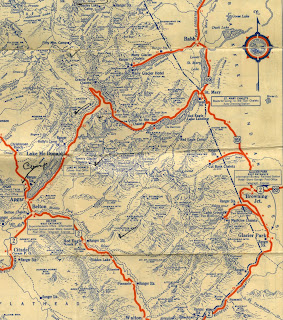The fire has burnt over about eight miles of the parks beautiful scenery before we got it under control. It burnt up all the many glacier chalets and the museum and some of the beautiful bridle paths were burnt up.
We came back in the camp today on the thirty first of August.
Robert
---------------------------------------------
Comments from Chris
Obviously, the fire wasn't as contained as Robert though in his previous post. Typically a fire as hot as this is going to have coals that smolder for days and can easily catch again.
Rolf Larson has an excellent story about this fire based on multiple first hand accounts. You can read it here - http://www.glacierparkfoundation.org/History/firestorm.html
Today is the day the Many Glacier Hotel almost burnt to the ground. The story is documented in Rolf's link. I've also included a map of the area below. Take a look at how the high winds took this fire from Heaven's Peak down in to the Swiftcurrent Valley.
Ten days in to the fire now.
 |
| Heaven's Peak From Robert's CCC Photo Collection |
 |
| Heaven's Peak and Many Glacier Hotel Robert's 1936 Glacier National Park Map |
 |
| Heaven's Peak on left. Swiftcurrent Pass at orange marker Google Maps |
 |
| Swiftcurrent Pass looking in to Swiftcurrent Valley Google Maps |





































